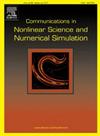An explicit positivity-preserving scheme for the Heston 3/2-model with order-one strong convergence
IF 3.4
2区 数学
Q1 MATHEMATICS, APPLIED
Communications in Nonlinear Science and Numerical Simulation
Pub Date : 2024-09-28
DOI:10.1016/j.cnsns.2024.108372
引用次数: 0
Abstract
This article is concerned with numerical approximations of the Heston 3/2-model from mathematical finance, which takes values in and possesses superlinearly growing drift and diffusion coefficients. To discretize the SDE model, a new Milstein-type scheme is proposed, which can be explicitly solved and is positivity-preserving unconditionally, i.e., for any time step-size . Furthermore, a mean-square convergence rate of order one is proved in the non-globally Lipschitz regime, which is highly non-trivial, by noting that the diffusion coefficient grows super-linearly. The above theoretical results can be then used to justify the multilevel Monte Carlo (MLMC) methods for approximating expectations of some functions of the solution to the Heston 3/2-model. Indeed, the unconditional positivity-preserving property is particularly desirable in the MLMC setting, where large discretization time steps are used. The obtained order-one convergence in turn promises the desired relevant variance of the multilevel estimator and justifies the optimal complexity for the MLMC approach, where is the required target accuracy. Numerical experiments are finally reported to confirm the above results.
具有一阶强收敛性的赫斯顿 3/2 模型的明确保正方案
本文关注数学金融学中赫斯顿 3/2 模型的数值近似,该模型取值范围为(0,∞),具有超线性增长的漂移和扩散系数。为了离散化 SDE 模型,我们提出了一种新的 Milstein 型方案,它可以显式求解,并且无条件地保有正向性,即对于任何时间步长 h>0。此外,通过注意到扩散系数的超线性增长,证明了在非全局 Lipschitz 体系中的均方收敛率为一阶,这非常非难。上述理论结果可用于证明多级蒙特卡洛(MLMC)方法的合理性,该方法用于近似海斯顿 3/2 模型解的某些函数的期望值。事实上,在使用大离散化时间步长的 MLMC 环境中,无条件的正向保留特性尤为重要。所获得的阶一收敛性反过来又保证了所需的多级估计器相关方差,并证明了 MLMC 方法的最佳复杂度为 O(ϵ-2),其中ϵ>0 是所需的目标精度。最后报告的数值实验证实了上述结果。
本文章由计算机程序翻译,如有差异,请以英文原文为准。
求助全文
约1分钟内获得全文
求助全文
来源期刊

Communications in Nonlinear Science and Numerical Simulation
MATHEMATICS, APPLIED-MATHEMATICS, INTERDISCIPLINARY APPLICATIONS
CiteScore
6.80
自引率
7.70%
发文量
378
审稿时长
78 days
期刊介绍:
The journal publishes original research findings on experimental observation, mathematical modeling, theoretical analysis and numerical simulation, for more accurate description, better prediction or novel application, of nonlinear phenomena in science and engineering. It offers a venue for researchers to make rapid exchange of ideas and techniques in nonlinear science and complexity.
The submission of manuscripts with cross-disciplinary approaches in nonlinear science and complexity is particularly encouraged.
Topics of interest:
Nonlinear differential or delay equations, Lie group analysis and asymptotic methods, Discontinuous systems, Fractals, Fractional calculus and dynamics, Nonlinear effects in quantum mechanics, Nonlinear stochastic processes, Experimental nonlinear science, Time-series and signal analysis, Computational methods and simulations in nonlinear science and engineering, Control of dynamical systems, Synchronization, Lyapunov analysis, High-dimensional chaos and turbulence, Chaos in Hamiltonian systems, Integrable systems and solitons, Collective behavior in many-body systems, Biological physics and networks, Nonlinear mechanical systems, Complex systems and complexity.
No length limitation for contributions is set, but only concisely written manuscripts are published. Brief papers are published on the basis of Rapid Communications. Discussions of previously published papers are welcome.
 求助内容:
求助内容: 应助结果提醒方式:
应助结果提醒方式:


